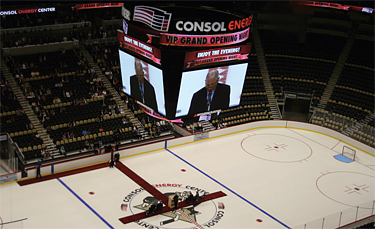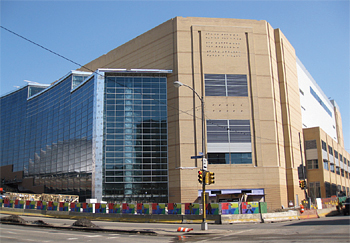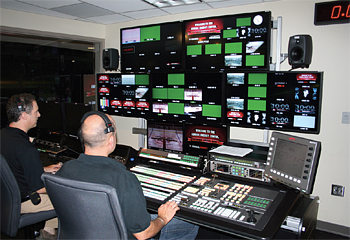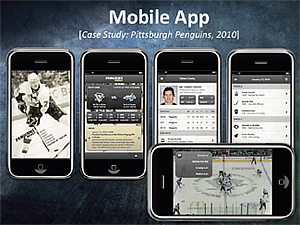NHL's Fire on Ice

The NHL's newest arena seats more than 18,000.
PITTSBURGH
The National Hockey League's Penguins franchise opened their new $321 million, 18,087-seat Consol Energy Center arena to the public on August 18. Two interactive exhibits engaged the fans that afternoon, and Sir Paul McCartney closed the grand opening day with the first of two concerts. The multisensory scene promised 'more to come' at Oct. 7's home opener.
A new arena is a bold investment in these hard economic times, more so when construction began in 2008, just weeks before the stock market tanked. But both the league and team seem to buck the trend.
The Penguins won the Stanley Cup in 2008/2009, a season deemed the NHL's most profitable in at least 12 years by Forbes magazine's November 2009 assessment. Fandom seemed healthy in 2009/2010 despite money problems reported for teams in Phoenix and Columbus, Ohio, and speculation of a lower than expected sale price for the Tampa Bay Lighting. The NHL itself reported that its 2009/2010 playoff run included "the most-watched NHL game in the U.S. in 36 years," while "total sales for the entire 2010 Stanley Cup Playoffs were up 22 percent."
TECHNOLOGY PARTNERSHIP
In tandem, providers of new technology solutions were offering some cool stuff.
On May 12, 2008, the Penguins announced a partnership with the Pittsburgh Technology Council to assess items to help "future-proof" the new facility. These included video technology and gaming stations, computerized and integrated lighting and sound systems, on-demand televised replays and touch-screen food menus for luxury suites, and improved electronic ticketing.

The Pittsburgh Penguins will inaugurate the Consol Energy Center as their new home at their season opener, Oct. 7. Through the partnership, the Penguins discovered YinzCAM Inc., a privately-held company spun off by a group at the Mobile Research Center at Carnegie Mellon University, (see sidebar).
YinzCAM, which was contracted after a test run at the team's previous home, Mellon Arena, enables fans at the game to experience live video from unique camera angles using their Wi-Fi enabled mobile phone or MP3 device. Fans can also "rewind" the live video to immediately watch a replay.
"We got it live in Mellon, I think, right after the new year," said team director of media technology, Chris DeVivo, of the mobile application. The fans loved it so much that the Penguins pushed for a 26-inch touchscreen version for the luxury suites.
This larger screen version, he said, would enable a viewer to press the touchscreen where the shot was taken, to call up four replay angles. It would also offer statistical pie charts, bar graphs and player comparisons.
"The YinzCAM team spent the summer developing a full blown suite application where we're pooling statistical information from NHL HITS [Hockey Information and Tracking System]," said DeVivo.
On a larger scale, the Penguins are offering broadcasters feeds from their hard cameras, RFs and robotics, potentially enabling coverage by close to 40 cameras. Team inventory includes Ikegami HDK77ECs, plus an Ikegami HDL-50 360 pan/tilt/zoom camera at center ice (all equipped with Canon lenses), and Sony PDW-F355 XDCAM HD camcorders.

Consol Energy Center's master control "The positions are at least double what we had at Mellon," said DeVivo. "We [now] have two concourses—there are both lower and upper slash cameras on each side—whereas at Mellon we had cameras just off of one level."
To get around the glass barrier separating fans from the action, the crew planned to cut a camera slot in the dasher boards at center ice and others at the double attack zone to give "a more close up and 'standing-next-to-them' type of XCU shot," he said. The slots will house small high definition robotic cameras.
The team also wanted to better balance the overall sound coming out of the arena for the networks.
"At our previous facility, most of the effects mics were at ice level," said DeVivo. "We've added numerous mic positions, both in the scoreboard and in the catwalk area above the scoreboard."
COORDINATION, CONNECTIVITY & ACCESS
In addition to coordinating all the different technologies brought in for the sizzle, the drawbacks of working at the team's former home presented its own list of items to do differently—like providing better connectivity for broadcasts.
YinzCAM Gives Camera Angles to FansPITTSBURGH
YinzCAM founder and CEO Priya Narasimhan is a self-confessed diehard fan of the Penguins and Steelers. She developed the YinzCAM mobile application to resolve the frustration of missing key plays from her seat in the nosebleed section of the stands.
From the start the application enabled multiple perspectives of key plays, plus stats, scores, video-on-demand, a roster and schedule, and the ability to capture moments for personal game diaries. It has since added location features to more easily find the nearest concession stand for a particular item, track a player, or even locate where the mascot is hiding. The last is a favorite option for her three-year-old son.
The YinzCAM smartphone app allows fans to view the action via alternate camera angles. The "Rock Your Jersey" where-wereyou-when... interactive selection is popular with fans worldwide. Users click on a map to place a marker (a blank jersey) where they are watching the game, then select a player's jersey to honor. "For one game we had 10,000 people around the world," said Narasimhan. "There were people over in Afghanistan and Iraq watching the game."
YinzCAM Suite, she said, was developed for the Penguins' principal owner: legendary hockey great Mario Lemieux. The Penguins have since rebranded their onsite applications "Penguins Mobile" and "Penguins Suite."
"I expect that every team will call it their own version of Suite and Mobile," said Narasimhan, who also cited contracts with four NFL teams: 49ers, Jaguars, Patriots, Steelers. "We also have a couple of teams with whom we have active negotiations underway."
Robin Berger "Mellon Arena was just a bunch of individual drops that weren't necessarily linked together—if any of the nationals came in and wanted to add a remote studio we had to 'home run' the cables," said DeVivo. "Here we put in a healthy amount of single mode and multimode fiber in addition to the triax. We put junction box interfaces anywhere that we could fit them. You can really move signals around the building."
Easy access to content was also important.
EditShare's storage solutions, Dalet's asset management system, and ContentVision's metadata configurations were instrumental in streamlining workflow. Technologies from Boston-based EditShare were adopted three years ago after the team discovered that its operations were huge "digital hoarders," making it difficult to meld and retrieve content.
"EditShare bent over backwards to make everything work—a big key to a lot of this file-based stuff," said DeVivo. "The shared storage was a great jump for us, especially since we went to XDCAMHD at the same time."
Technology from Dalet Digital Media Systems and Pittsburgh-based ContentVision was added for the new arena. The combination enables the team to record six channels live (plus four channels on its EVS XT server).
DeVivo said he chose Dalet's system because of its multiple-user interface and "exceptional configurability."
"It's going to allow us to do a lot of back-office policy setting, migration rules and automation," he said. "It's the key to delivering content to all of these different platforms [YinzCAM, Cisco StadiumVision, external TV sets, Web and mobile]."
DeVivo is a huge fan of ContentVision's technology, a key ingredient in enabling his crew to look at any play from all angles without having to manually search through every video clip.
"ContentVision pools the statistical information from the NHL, parses out what we want, and then passes the metadata through to Dalet, which associates it with video that we are recording," he said. "The searchable metadata and video is then available in near real time to video editors in the building."
DeVivo added that the team will eventually make certain video streams available to the general admission seats.
"We'll use the YinzCAM interface to [searchable] video archives, some 360 degree camera technology, and other neat features that will give the fans that 'on-demand' feel in the stands," said DeVivo. "It's on the roadmap."

Get the TV Tech Newsletter
The professional video industry's #1 source for news, trends and product and tech information. Sign up below.
